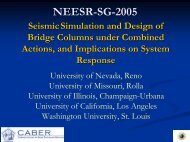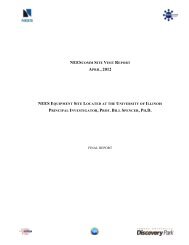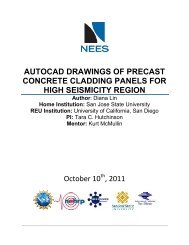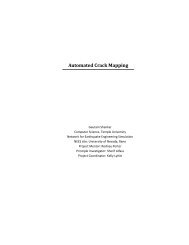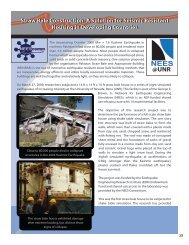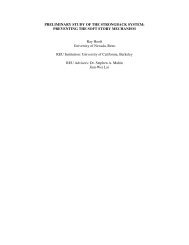TSUNAMI WAVE BREAKING BEHAVIOR ON A REEF WITH A ...
TSUNAMI WAVE BREAKING BEHAVIOR ON A REEF WITH A ...
TSUNAMI WAVE BREAKING BEHAVIOR ON A REEF WITH A ...
You also want an ePaper? Increase the reach of your titles
YUMPU automatically turns print PDFs into web optimized ePapers that Google loves.
3.2 Instrumentation<br />
Instruments were used for this particular aspect of the project to<br />
determine the free surface profile of the water as a wave passed. Fourteen<br />
resistance-type parallel wire wave gauges and eight sonic wave gauges<br />
(Figure 4) recorded the height of the waves over time and were positioned<br />
down the length of the tank in the horizontal x-direction. The<br />
measurements from these instruments were used to record the actual<br />
wave height Ho and compare the values to the experimental Ho, the<br />
number that was entered into the wavemaker computer. The actual wave<br />
height values were typically 3-5% lower than the wave height input in the<br />
computer, and therefore the difference was not taken into account in this<br />
analysis.<br />
Figure 4: Wave measurement<br />
instrumentation: sonic wave<br />
gauge (left) and wire wave<br />
gauge (right)<br />
3.3 Wave Trials<br />
In order to gather a broad spectrum of data, waves were run at combinations of 9 different wave height<br />
ratios and 5 different water depths (0cm, 5cm, 10cm, 20cm, and 30cm above the flat reef). Trials of<br />
wave height ratios equal to 0.1, 0.2, 0.3, 0.4, and 0.5 were run twice in order to test repeatability. By<br />
combining these variables in different ways, different aspects affecting the waves could be isolated.<br />
Waves were run every 20-30 minutes in order to allow the water to settle.<br />
3.4 Breaking Index and Breaker Type<br />
There are four ways in which breaking waves can be classified. These “breaker types” are spilling,<br />
plunging, collapsing, and surging. Spilling waves are characterized by a crest that becomes unstable and<br />
then cascades down the shoreward face of the wave. In plunging breakers, the crest of the wave curls<br />
over the face of the wave and falls into the base, what surfers refer to as pipelines. In collapsing waves,<br />
the crest remains stable and unbroken while the lower part of the shoreward face steepens and then<br />
falls to produce a turbulent flow. Surging waves practically don’t break, as the front face of the wave<br />
just advances towards the beach. The surf similiarity parameter, ξo (Eq. 1), is typically used to classify<br />
the waves based on wave height Ho and period Lo (Demirbilek and Vincent, 2002). However, the slope<br />
parameter So (Eqn 2) can also be used and has a 99.9% correlation to the surf similarity parameter. This<br />
is the parameter that was used in this experiment as it is in a form that can be used for solitary waves by<br />
substituting an approximation for Lo (Eqn 3) since solitary waves are infinite in wave length. (Grilli et al.<br />
1997). The slope parameter was used because it is derived from the Boussinesq equation and therefore<br />
considered to be a mathematically derived as opposed to experimentally. After calculating So, the<br />
following guidelines were used in determining the breaker types of the waves in this experiment:<br />
surging breaking= 0.3






